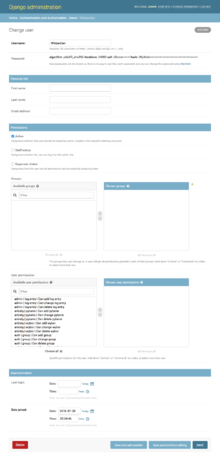| Version
|
Release Date[35]
|
End of mainstream support
|
End of extended support
|
Notes[36]
|
| Old version, no longer maintained: 0.90[37] |
16 Nov 2005 |
|
|
|
| Old version, no longer maintained: 0.91[38] |
11 Jan 2006 |
|
|
"new-admin"
|
| Old version, no longer maintained: 0.95[39] |
29 Jul 2006 |
|
|
"magic removal"
|
| Old version, no longer maintained: 0.96[40] |
23 Mar 2007 |
|
|
"newforms", testing tools
|
| Old version, no longer maintained: 1.0[41] |
3 Sep 2008 |
|
|
API stability, decoupled admin, unicode
|
| Old version, no longer maintained: 1.1[42] |
29 Jul 2009 |
|
|
Aggregates, transaction based tests
|
| Old version, no longer maintained: 1.2[43] |
17 May 2010 |
|
|
Multiple db connections, CSRF, model validation
|
| Old version, no longer maintained: 1.3[44] |
23 Mar 2011 |
23 Mar 2012 |
26 Feb 2013 |
Class based views, staticfiles
|
| Old version, no longer maintained: 1.4 LTS[45] |
23 Mar 2012 |
26 Feb 2013 |
1 Oct 2015 |
Time zones, in browser testing, app templates.
|
| Old version, no longer maintained: 1.5[46] |
26 Feb 2013 |
6 Nov 2013 |
2 Sep 2014 |
Python 3 Support, configurable user model
|
| Old version, no longer maintained: 1.6[47] |
6 Nov 2013 |
2 Sep 2014 |
1 Apr 2015 |
Dedicated to Malcolm Tredinnick, db transaction management, connection pooling.
|
| Old version, no longer maintained: 1.7[48] |
2 Sep 2014 |
1 Apr 2015 |
1 Dec 2015 |
Migrations, application loading and configuration.
|
| Old version, no longer maintained: 1.8 LTS[49] |
1 Apr 2015 |
1 Dec 2015 |
1 Apr 2018 |
Native support for multiple template engines. Support ended on 1 April 2018
|
| Old version, no longer maintained: 1.9[50] |
1 Dec 2015 |
1 Aug 2016 |
4 Apr 2017 |
Automatic password validation. New styling for admin interface.
|
| Old version, no longer maintained: 1.10[51] |
1 Aug 2016 |
4 Apr 2017 |
2 Dec 2017 |
Full text search for PostgreSQL. New-style middleware.
|
| Old version, no longer maintained: 1.11 LTS[52] |
4 Apr 2017 |
2 Dec 2017 |
1 Apr 2020 |
Last version to support Python 2.7. Support ended on 1 April 2020
|
| Old version, no longer maintained: 2.0[53] |
2 Dec 2017 |
1 Aug 2018 |
1 Apr 2019 |
First Python 3-only release, Simplified URL routing syntax, Mobile friendly admin.
|
| Old version, no longer maintained: 2.1[54] |
1 Aug 2018 |
1 Apr 2019 |
2 Dec 2019 |
Model "view" permission.
|
| Old version, no longer maintained: 2.2 LTS[55] |
1 Apr 2019 |
2 Dec 2019 |
11 Apr 2022 |
Security release.
|
| Old version, no longer maintained: 3.0[56] |
2 Dec 2019 |
3 Aug 2020 |
6 Apr 2020 |
ASGI support
|
| Old version, no longer maintained: 3.1[57] |
4 Aug 2020 |
6 Apr 2020 |
7 Dec 2021 |
Asynchronous views and middleware
|
| Older version, yet still maintained: 3.2 LTS[58] |
6 Apr 2021 |
7 Dec 2021 |
April 2024 |
Tracking many to many relationships, added support for Python 3.11
|
| Old version, no longer maintained: 4.0[59] |
7 Dec 2021 |
3 Aug 2022 |
April 2023 |
Support for pytz is now deprecated and will be removed in Django 5.0.
|
| Old version, no longer maintained: 4.1[60] |
3 Aug 2022 |
April 2023 |
December 2023 |
Asynchronous ORM interface, CSRF_COOKIE_MASKED setting, outputting a form, like (( form ))
|
| Older version, yet still maintained: 4.2 LTS[61] |
3 Apr 2023 |
December 2023 |
April 2026 |
Psycopg 3 support, ENGINE as django.db.backends.postgresql supports both libraries.
|
| Current stable version: 5.0 |
4 Dec 2023 |
August 2024 |
April 2025 |
|
Legend: Old version Older version, still maintained Latest version Latest preview version Future release |

